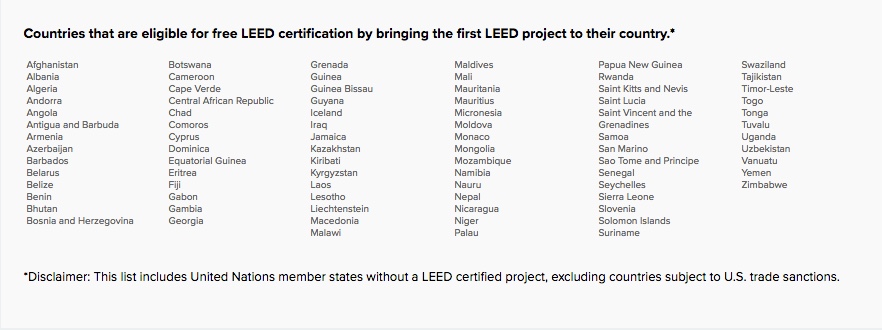No products in the cart.
Is LEED Certification International? An Introduction to LEED Earth
Yes, LEED Certification is intended to be international, and this flexibility is part of the reason why LEED Certification has grown to be the most widely used green building rating system in the world, with 1.85 million square feet of construction space certifying every day.
If that statistic alone is enough to get you pumped about LEED Certification, enough to make you want to learn more about it right now, visit our What is LEED Certification? series and become familiar with the basic terms, certification process, and benefits.
The U.S. Green Building Council (USGBC), the organization that created the LEED standards, offers two awesome opportunities to encourage LEED Certification around the world. The opportunities fall under what’s called the LEED Earth campaign.
What is LEED Earth?
LEED Earth is a campaign that offers LEED Certification at no cost to two types of building projects:
- The first projects to certify in the over 100 countries where LEED has yet to take root
- The first LEED Platinum project in any country to certify using the newest version of LEED (LEED v4)
What this means is that LEED Earth encourages green-building trailblazers in developing countries to bring LEED Certification and environmental awareness to their communities.
Benefits of the LEED Earth Campaign
This is a tremendous opportunity for individuals to stand out from other professionals in their field – by potentially being one of the first professionals in their country to earn a LEED professional credential as well as a free LEED Certification achievement. While others may eventually share in those achievements, nobody can compare to the person who earned it first.
There is a massive opportunity for personal marketability and a somewhat intangible benefit of revolutionizing real estate development in developing countries. After the notoriety earned from that first LEED Certification project, one might expect to see more eyes being opened to the benefits of green building and eventually more LEED Certification projects to follow suit.
The USGBC has identified the countries that remain eligible to participate in the LEED Earth campaign. Click the image to see a larger version in a new window.
Currently, there are a total of 32 countries recognized by the LEED Earth campaign. In early June 2017, the USGBC highlighted recent additions to the campaign, including Armenia, Trinidad and Tobago, French Polynesia, Nigeria, Oman, Morocco, Montenegro and Cambodia. Costa Rica achieved its first LEED v4 Platinum building as part of the program.
Why USGBC Wants to Encourage LEED v4 Platinum Projects
With regard to the second type of building project, the USGBC wants to encourage building professionals to implement the newest strategies and technologies, knowing that such practices result in greater energy savings and indoor air quality.
Every few years, the USGBC undergoes a rigorous review of its LEED standards and debuts an updated version of the program. The most recent version, called LEED Version 4, was introduced in late 2014.
Project teams were given an opportunity to choose between satisfying LEED 2009 standards or LEED v4 standards when pursuing LEED Certification for their building projects. The USGBC initially set a deadline for June 2015 as the time when all projects had to register under LEED v4 guidelines. However, the market needed additional time to understand the changes from LEED 2009 to LEED v4, so the USGBC pushed the deadline to October 31, 2016. Now, all LEED projects must pursue certification under the LEED v4 standards.
Since LEED Certification is still trickling to various countries, the shift to LEED v4 has equally trickled down. Therefore, the USGBC wants to reward project teams that certify under the newest version. The second part of the LEED Earth campaign pushes project teams to not only pursue LEED v4 but to achieve the highest possible certification level, which is LEED Platinum. This results in the best-of-the-best design, construction, and operations practices.
While this may appear daunting, the prospect of earning that LEED Platinum Certification at no cost is rather appealing.
How to Join the LEED Earth Campaign
If you’re reading this post, and you live in any of the countries listed in the graphic above, you should definitely consider earning a LEED credential and aspiring to earn the free LEED Certification for your country.
Your first step will be to enroll in LEED Green Associate training and pass the LEED Green Associate exam. From there, you might choose to advance to a LEED AP professional credential or begin working with a project team on a potential LEED Certification project.
You should also visit the LEED Earth website and request information from the USGBC regarding any necessary paperwork to officially record your involvement with the campaign.
The LEED Earth campaign is such a great idea and awesome opportunity that will continue to support LEED Certification internationally. As a USGBC Education Partner, we at Everblue would love to assist you in your journey of LEED knowledge. Our LEED training courses are comprehensive and include a vast range of study materials. I’m pumped thinking about how much you will learn and the positive environmental impact and economic growth that you can bring to your community!
Start learning about LEED today – our online training courses give you immediate access to the knowledge. LEED Certification is available internationally, and so is LEED training! Call us at (800) 460-2575 to get started!
